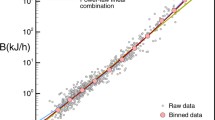Abstract
In larger animals a considerable part of the total body mass (e.g. body water, dissolved substances, mineral and organic deposits) does not consume significant amounts of oxygen. These materials can be considered to form a metabolically inert infrastructure which mainly serves three functions: (1) structural support to the organism, (2) storage of nutrients (building material and energy stores) and (3) transport and distribution of these materials. Considering the transport and support function of the metabolically inert structures and their interconnections it is likely that the infrastructure will basically show some tree-like, branching building plan. The weight of the metabolically inert infrastructure of an organism, can be given by bW/(c+W), in which W=body weight, b and c are constants. With increasing size the weight of the metabolic inert infrastructure increases disproportionably. Experimental data concerning basic metabolic rate (M) in relation to body weight (W) better fit the equation M=a W(1-bW)/(c+W), (a=constant) than the conventional power law.
Similar content being viewed by others
References
Bridgeman, (1931). Dimensional Analysis. Connecticut, Yale university Press.
Fenchel, T. (1974). Oecologia 14: 317.
Gray, B.F. (1981). On the “surface law” and basal metabolic rate. J. Theor. Biol. 93: 757–767.
Günther, B. (1975). Biological similarities. Physiol. Rev. 55: 659.
Günther, B., E. Morgado and U. Gonzalez (1993). Oxidative metabolism and body weight: inactive, active and mitochondrial volumes. Biol. Res. 26: 341–355.
Hemmingsen, A.M. (1960). Metabolism in relation to body size. Rep. Steno Mem. Hosp. Nordisk insulin lab. 9: 1–110.
Kleiber, M. (1961). Fire of Life — An Introduction to Animal Energetics. New York, Wiley.
Platt, T. and W. Silvert (1981). Ecology, physiology, allometry and dimensionality. J. Theor. Biol. 93: 855–860.
Prosser, C.L. (1973). Oxygen: respiration and metabolism. In: C.L. Prosser, ed., Comparative Animal Physiology, pp. 165–211 Philadelphia, London, W. B. Saunders.
Schmidt-Nielsen, K. (1984). Scaling, why is Animal Size so Important? Cambridge University Press.
Spaargaren, D.H. (1992). Transport function of branching structures and the “surface law” for basic metabolic rate. J. Theor. Biol. 154: 495–504.
Suarez, R.K. (1992). Hummingbird flight: sustaining the highest mass specific metaolic rates among vertebrates. Experientia 48: 565–570.
Wilkie, E.R. (1977). In: T.J. Pedley, ed., Scale Effects in Locomotion. London, Academic Press.
Author information
Authors and Affiliations
Rights and permissions
About this article
Cite this article
Spaargaren, D.H. Metabolic rate and body size. Acta Biotheor 42, 263–269 (1994). https://doi.org/10.1007/BF00707392
Received:
Issue Date:
DOI: https://doi.org/10.1007/BF00707392




